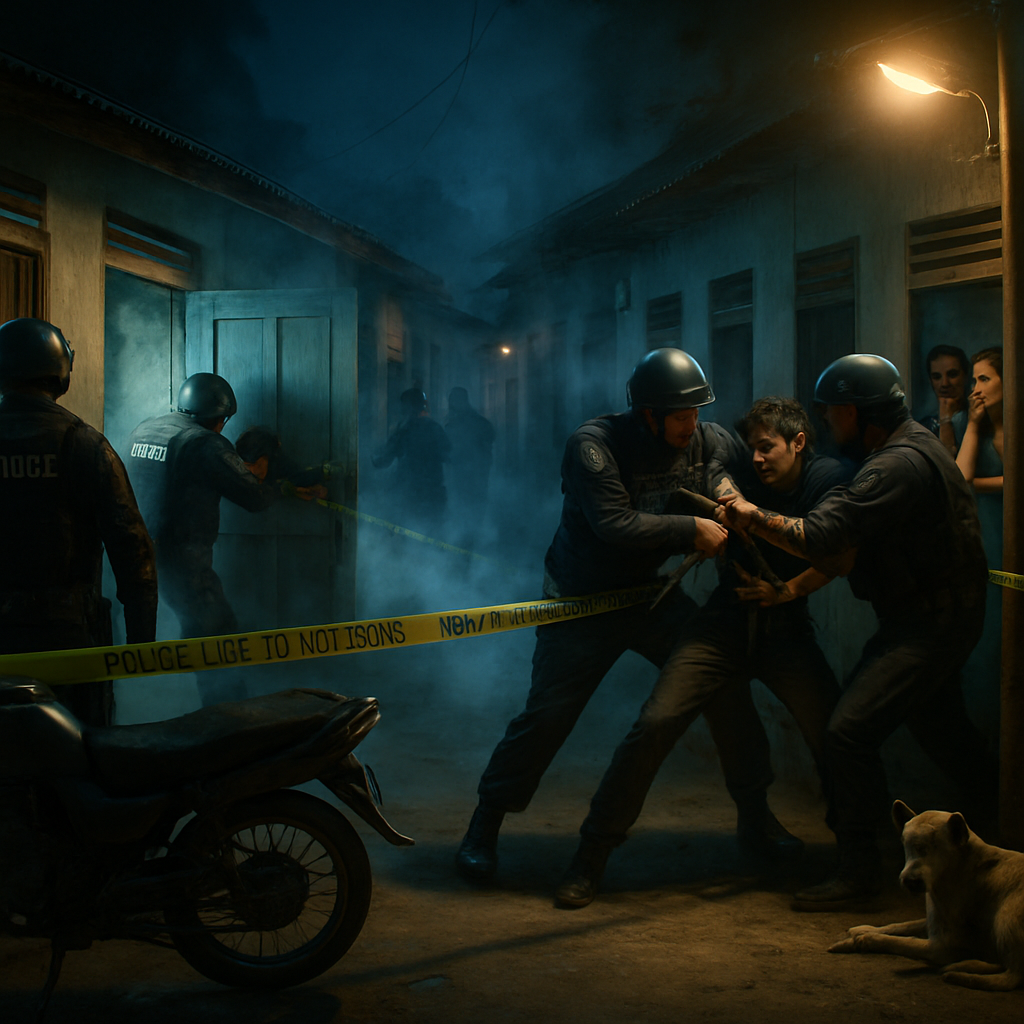Chaos erupted in Tha Sae district, Chumphon province on November 20 when a 40-year-old man allegedly high on drugs and armed with an M16 rifle rampaged through a small neighbourhood, killing one person and critically wounding another before police brought the situation to an end with tear gas and a forced entry.
Police identified the suspect as Natruethep Rintawong. According to officers and eyewitnesses, the incident began earlier in the day when Natruethep reportedly took a neighbour’s car — the vehicle of 27-year-old Kittisak Kirdkuha — and fled the accommodation complex where both men lived.
Kittisak, alarmed to find his car missing, pursued Natruethep on a motorcycle. The pursuit ended about two kilometres from the accommodation when Natruethep allegedly opened fire with an M16 rifle. Kittisak was struck in the cheek and left in critical condition at a local hospital.
Instead of fleeing the area after the shooting, Natruethep returned to the accommodation and, according to police, fatally shot another neighbour, 29-year-old Thananchai Thong-ngen. Disturbingly, reports say the rampage also included the killing of a neighbour’s dog before the suspect barricaded himself inside his rented room.
Within hours more than 50 officers were on the scene, creating a tense perimeter around the housing compound. Officers engaged in attempts to negotiate with Natruethep for more than two hours, according to police reports, but the suspect refused to surrender.
When talks failed, police deployed tear gas and forced entry into Natruethep’s room. A dramatic moment came as officers reported the suspect still clutched the M16 and attempted to fire, but the firearm malfunctioned. With the rifle failing to discharge, officers were able to disarm and arrest Natruethep without sustaining injuries. Tension flared briefly when an angry relative of one of the victims lunged toward the suspect with a hammer; police intervened and prevented further violence.
Natruethep has been charged with intentional murder, unlawful possession of a military-grade firearm, and firing a weapon in a public area. Authorities say narcotics use appears to have played a major role in the rampage, though some local reports suggest that long-running personal disputes between Natruethep and the victims may also have contributed. Police said investigations are ongoing as they piece together motive, timeline, and additional evidence.
The incident has reignited public concern about the availability of military-grade weapons, mental health, and drug abuse in communities across Thailand. In a grim echo from earlier this year, a separate case in Surin province also involved an M16 rifle when a soldier wounded two civilians before taking his own life — a case that sparked debate about access to military firearms and support for people in crisis.
Residents of the Tha Sae district described a community left shaken and searching for answers. “It felt like a war zone,” one neighbour told local reporters, asking to remain anonymous. “We never imagined something like this would happen here.” The violent event Saturday left families grieving and many in the neighbourhood calling for clearer controls on firearms and stronger responses to drug-related disturbances.
Police have not released additional details about how Natruethep acquired the M16 or whether there were prior complaints about his behaviour, citing the active investigation. For now, the legal process will determine how the case proceeds and whether prosecutors can establish motive beyond the alleged influence of narcotics.
Hospitals continue to monitor Kittisak’s condition as investigators collect statements, forensic evidence, and surveillance footage. Authorities urged anyone with information or footage from the scene to come forward to assist in the probe.
As the small seaside province of Chumphon reels from the violence, the episode raises broader questions about community safety, the intersection of drugs and firearms, and how quickly local tensions can escalate into tragedy. For neighbours pacing the compound and families planning funerals, the hope is that a thorough investigation and a transparent legal process will bring clarity — and, eventually, some measure of closure.
- Where: Tha Sae district, Chumphon province
- When: November 20
- Suspect: Natruethep Rintawong, 40
- Victims: Thananchai Thong-ngen, 29 (killed); Kittisak Kirdkuha, 27 (critically wounded)
- Weapon: M16 rifle (allegedly)
- Charges: Intentional murder, unlawful possession of military-grade firearm, firing a weapon in public
Police say they will provide further updates as the investigation continues and legal proceedings move forward. For now, the quiet streets of Tha Sae have been punctured by grief and the urgent need for answers.


















This is terrifying and it shows how easily military weapons can surface in civilian areas. We need strict controls and quick action to take guns off the streets. How did an M16 end up in a housing compound anyway?
Maybe it was stolen from a soldier or sold on the black market, we hear that all the time. I blame the military supply chain and corrupt dealers more than the addict.
I agree corruption in supply chains matters, but addiction and local disputes also look like big parts of this tragedy. Both angles deserve investigation.
Black market guns are everywhere, true, but people forget poverty and lack of mental health help push folks over the edge.
This reads like a failure of social services and law enforcement prevention. If neighbors had raised alarms sooner or if there were better drug programs maybe this could have been stopped.
Easy to say after the fact. The police tried negotiations for hours and got him without hurting anyone. Hindsight critiques don’t help the grieving family.
Negotiation worked in the end, yes, but the whole episode never should have happened. Prevention is cheaper than crisis response.
Why would someone shoot a dog too? That part made me cry. It feels like evil or really bad drugs.
Killing an animal in such contexts can indicate disinhibition from substances, an attempt to intimidate, or deep personal animus. We shouldn’t reduce it to ‘evil’ without understanding the psycho-social drivers.
Thanks, that explains it better. I still think there should be harsher punishments so this doesn’t happen again.
As someone who lives in rural areas, this scares me. Military-style weapons in civilian hands are a recipe for disaster when drugs are involved.
Legally, possession of an M16 is a severe offense and the prosecution will likely push for the maximum. But the court will also need evidence of intent beyond drug influence.
I hope they actually enforce the laws this time and trace how the firearm was obtained. It’s not enough to arrest one man and move on.
Sometimes justice systems are slow and biased, though. Will the victim’s family get closure or will it be dragged out for years?
Thai courts can be slow, but high-profile cases with public pressure tend to move faster. The family should consult a criminal lawyer to stay informed.
The community trauma can’t be overstated. People who live there will be looking over their shoulders for a long time and kids will be affected.
We also have to tie substance abuse policy to firearm control and mental health interventions. Fragmented services mean people fall through the cracks.
I’d add that frontline police need better training to spot escalation and coordinate with health services before situations erupt.
Training is fine, but if departments are understaffed and underfunded, it’s a hollow solution. Systemic investment is required.
This is nuts. M16 in a housing complex? How does that even happen?
The mention of a malfunctioning M16 that saved lives is chilling. Sounds like a miracle, but luck shouldn’t be part of public safety plans.
Miracle or not, the fact that it misfired is probably the only reason more people weren’t killed. We should focus on removing weapons and treating addiction.
Exactly. Both removal and treatment. Otherwise we’re just waiting for the next headline.
As a neighbour I would be angry at the landlord too if someone rented a room with a gun in it. Who screens tenants in those compounds?
Landlords usually can’t screen for firearms, but they can evict when illegal activity is reported. Still, eviction is after-the-fact.
So what should tenants do? Move? It’s not fair to blame victims who live next to a dangerous person.
The police asked for footage and statements; local cameras might reveal a prior pattern of violence or where he got the gun. Forensics will matter.
Medical teams are also collecting evidence in the wounded man’s treatment records. Injuries and toxicology can help build the case.
Toxicology could prove recent drug use but not necessarily intent. Still, it’s valuable for sentencing and rehab orders.
We must be cautious: toxicology results inform context but shouldn’t be used to absolve accountability. Courts need nuanced interpretation.
Why are military-grade weapons so accessible in civilian markets? Someone is leaking gear or criminals are fabricating parts.
There are illegal workshops and also corrupt transfers. The supply chain needs transparency and accountability from militaries.
Agreed, but transparency sounds idealistic. We need concrete audits and punitive measures for negligence within the supply system.
I think people rushing to blame guns ignore the human relationships here. The article mentions personal disputes — that matters too.